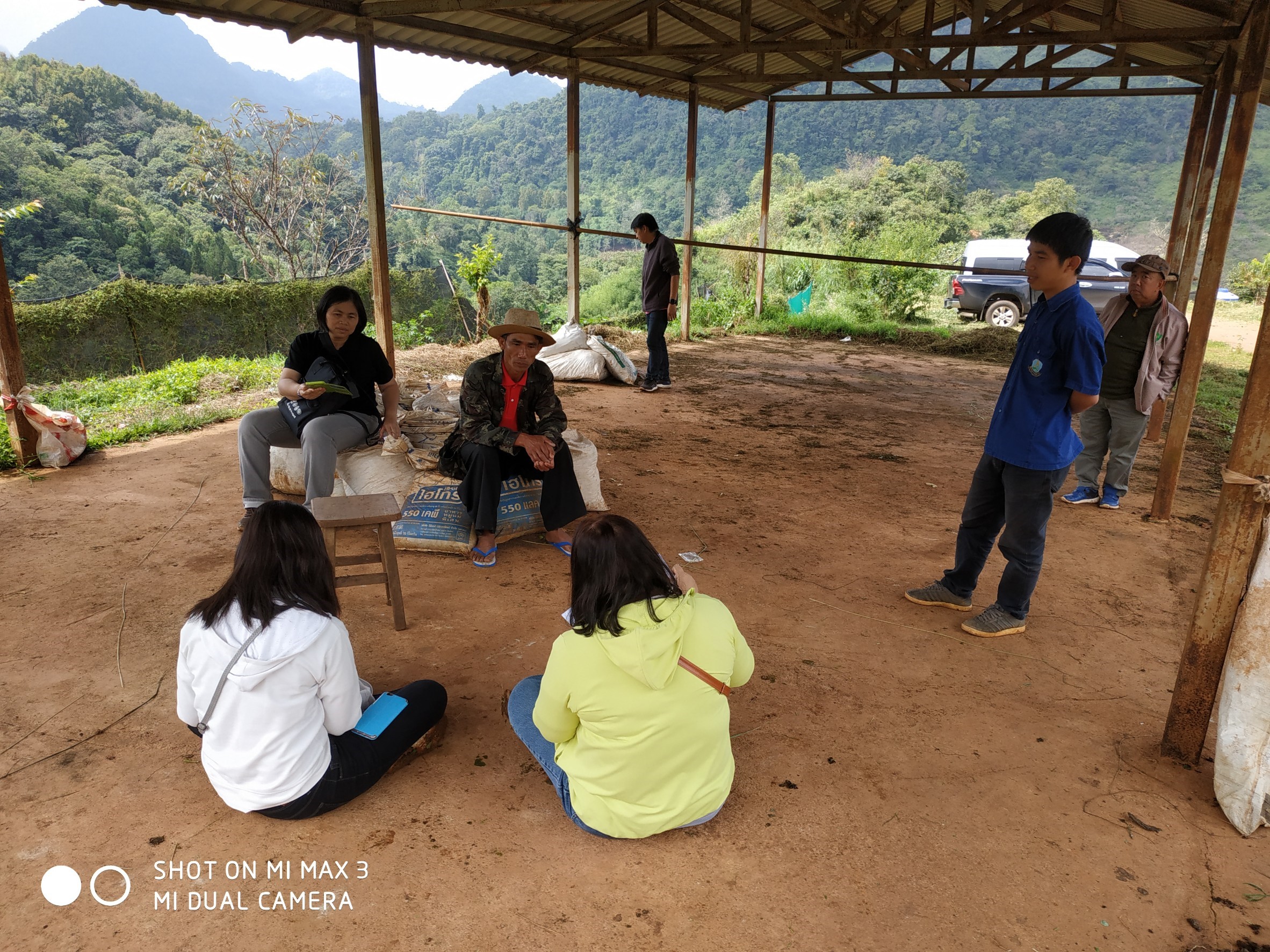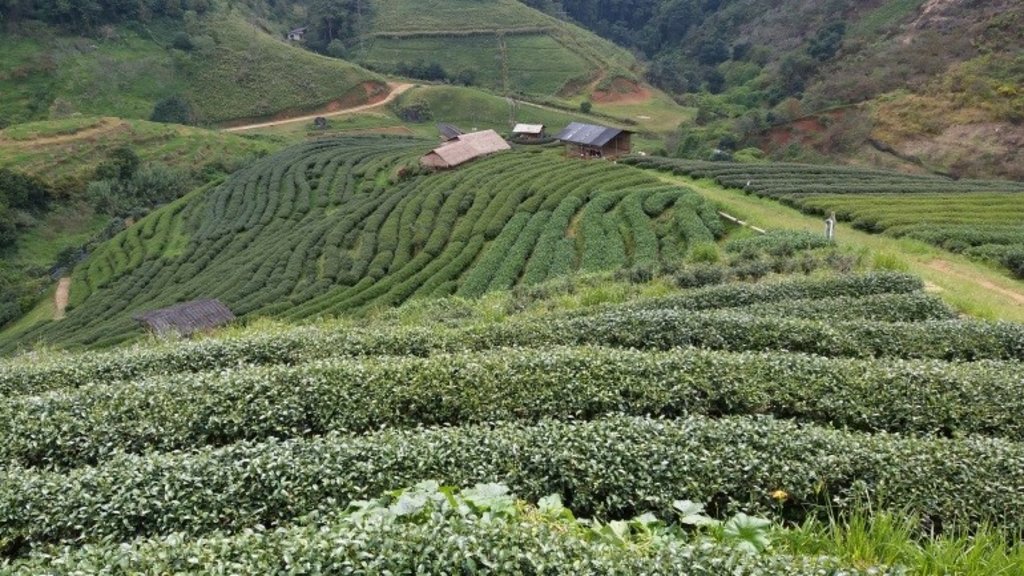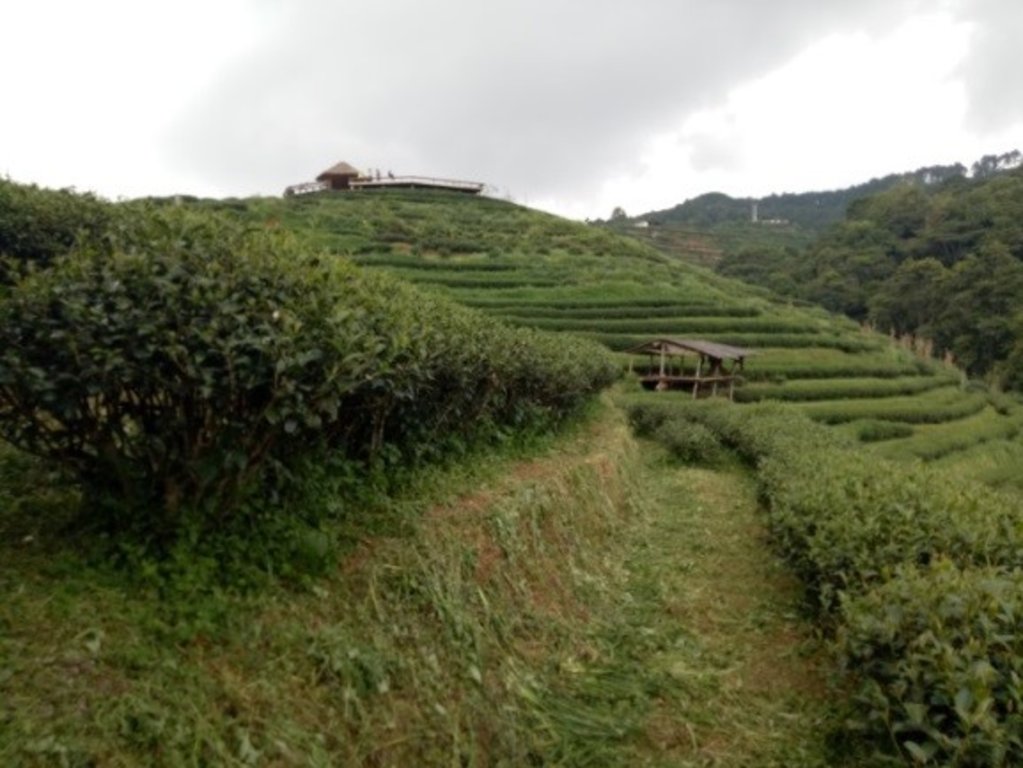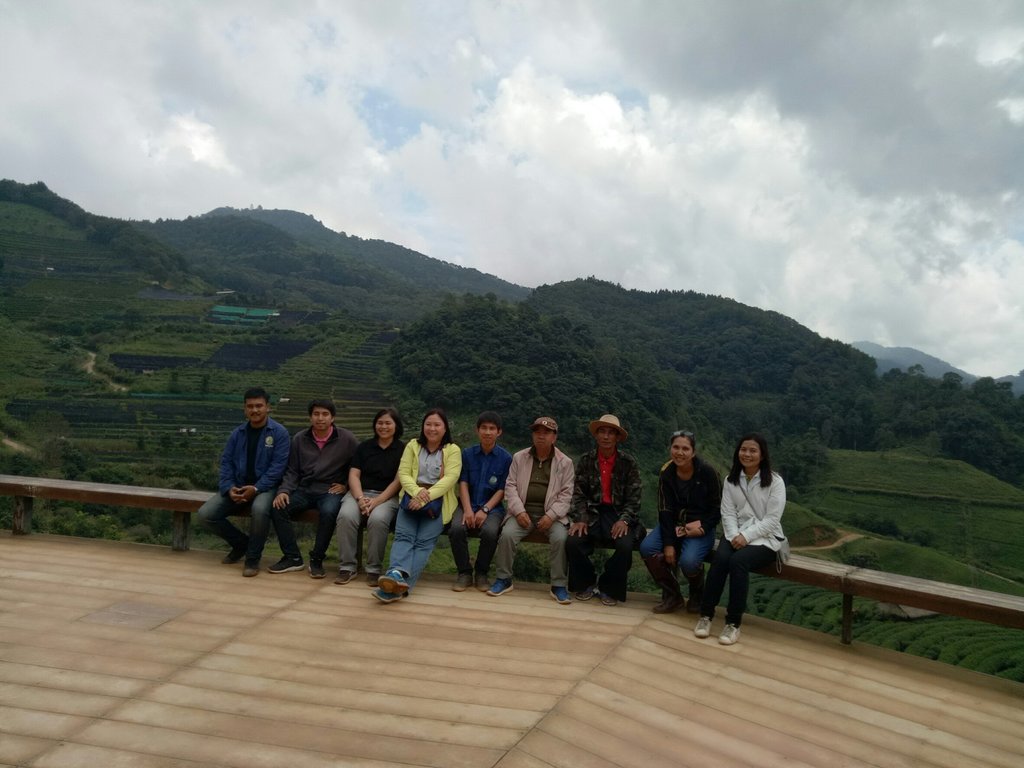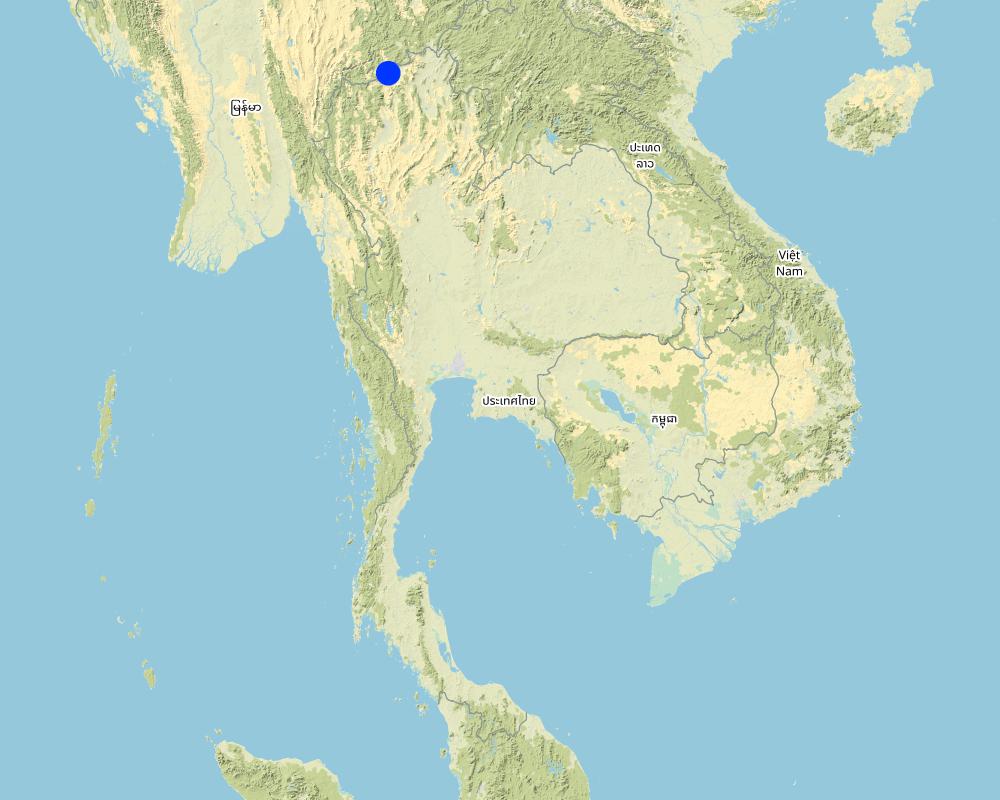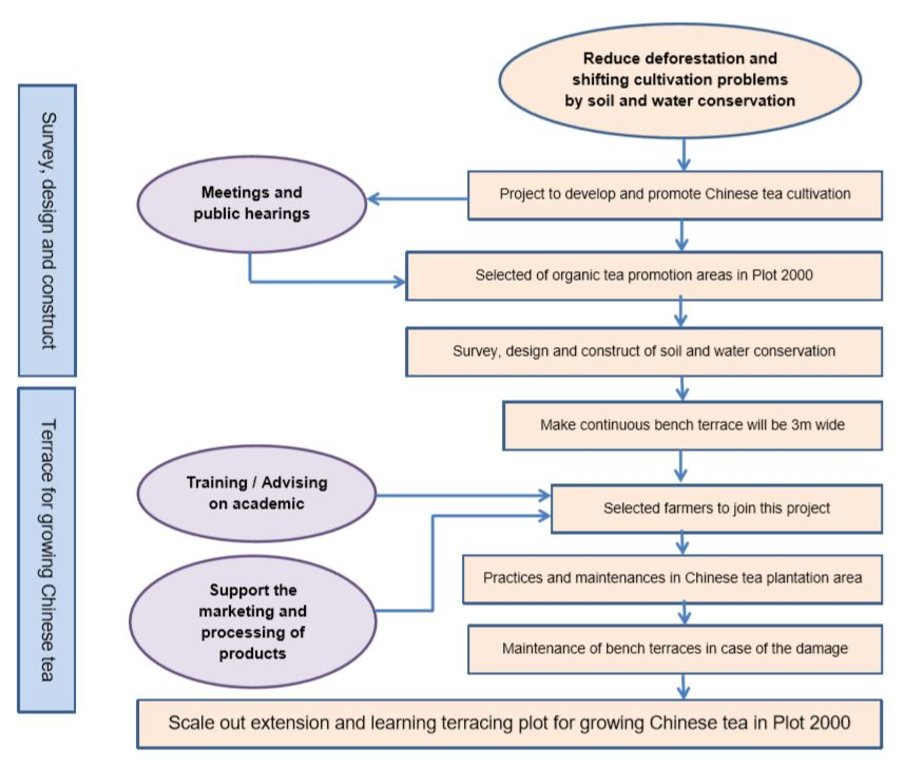Promotion of Organic Tea Production under Bench Terraces [Thaïlande]
- Création :
- Mise à jour :
- Compilateur : Pitayakon Limtong
- Rédacteur : –
- Examinateurs : Rima Mekdaschi Studer, William Critchley
Continuous bench terrace
approaches_4282 - Thaïlande
Voir les sections
Développer tout Réduire tout1. Informations générales
1.2 Coordonnées des personnes-ressources et des institutions impliquées dans l'évaluation et la documentation de l'Approche
Personne(s) ressource(s) clé(s)
co-compiler:
Tipvong Tanomkwan
1760 ต่อ 2235 / 0879172421
aoy.tvong.@gmail.com
Land Development Department
Pahotyothin Rd., Chatuchak, Bangkok 10900
Thaïlande
exploitant des terres:
Mokngoen Jai
0658720601 / -
- / -
Palaung hill tribe, land user in Plot 2000
Mu 5, Khum village, Mae Ngon sub-district, Fang district, Chiang Mai province, 50110
Thaïlande
Tapangtong Werapong
0987488087 / -
- / -
Angkhang Royal Agricultural Station
Mu 5, Khum village, Mae Ngon sub-district, Fang district, Chiang Mai province, 50110
Thaïlande
Boonchoo Sontaya
- / -
- / -
Royal Project Land Development Center, Land Development Department
164 Mu 3, Chiang Mai-Fang Road, Don Kaeo subdistrict, Mae Rim district, Chiang Mai province, 50180
Thaïlande
Nom du ou des institutions qui ont facilité la documentation/ l'évaluation de l'Approche (si pertinent)
Land Development Department (Land Development Department) - Thaïlande1.3 Conditions relatives à l'utilisation par WOCAT des données documentées
Quand les données ont-elles été compilées (sur le terrain)?
19/10/2018
Le compilateur et la(les) personne(s) ressource(s) acceptent les conditions relatives à l'utilisation par WOCAT des données documentées:
Oui
2. Description de l'Approche de GDT
2.1 Courte description de l'Approche
Promotion of continuous bench terraces for sustainable tea plantations in steep areas of the northern region highlands.
2.2 Description détaillée de l'Approche
Description détaillée de l'Approche:
The approach is to develop and promote sustainable agriculture on steep slopes by establishing continuous bench terraces. Under this system, hilltribe farmers can produce good quality Chinese tea, and send their product to a processing factory nearby, which will create stable and high incomes and raise the quality of life. This production/ conservation system aims also to reduce deforestation and shifting cultivation problems, which lead to the degradation of soil and land. As such, soil and water conservation in this upstream sloping highland should promote and encourage appropriate sustainable land management to preserve natural resources and the environment.
In the early stage, Angkhang Royal Agricultural Station initiated this project to develop and promote Chinese tea cultivation on steep land, with close cooperation from the Land Development Department (LDD) to design the continuous bench terraces instead of the cold-climate fruit trees, which had greatly deteriorated. Local officers had allocated land (without ownership) to Palaung hilltribe people who were selected and guaranteed by the community leader for their aptitude and ability to cultivate Chinese tea according to the Good Agricultural Practices (GAP) Guidelines, and set up a Chinese tea producers group at Plot 2000. Angkhang Royal Agricultural Station organized this programme and trained them and also arranged for some local officers to advise on soil management, fertilizer use, and disease and pest control. Vetiver grass planting was introduced to maintain the terrace and road edges; compost was produced to use for improving soil properties and reducing their production cost, and cultivation materials were supplied to all land users through disbursement under the management of Doi Angkhang Agricultural Cooperatives. Local officers also supported marketing through purchasing at the guaranteed price according to the quality of the tea, and set up tea processing factories in this area. The project encourages all land users to observe and maintain their tea bushes and the land around them. Currently all land users are aware of how to sustainably use and maintain their land and soil resources. Moreover, local officers advise how to repair bench terraces themselves; however, if the damage is serious, the LDD officers will come in to help them repair.
2.3 Photos de l'approche
Remarques générales concernant les photos:
Data collection supports for mainstreaming and scaling-up of sustainable land management
2.4 Vidéos de l'Approche
Commentaire, brève description:
Tea plantation in soil and water conservation measure in steep areas
Date:
09/10/2018
Lieu:
Doi Ang Khang
Nom du vidéaste:
Ms. Somjit Lertdisayawan / Ms. Tanomkwan Tipvong
Commentaire, brève description:
Tea plantation farm
Date:
21/01/2016
Lieu:
Doi Angkhang
Nom du vidéaste:
Pornthep Molee
Commentaire, brève description:
Angkhang Royal Agricultural Station
39 เส้นทาง เรียนรู้ ทำดี “ตามรอยพ่อ”
Date:
15/03/2017
Lieu:
Angkhang Royal Agricultural Station
Nom du vidéaste:
Royal Project Foundation, Ford Thailand
2.5 Pays/ région/ lieux où l'Approche a été appliquée
Pays:
Thaïlande
Région/ Etat/ Province:
Chiang Mai Province
Autres spécifications du lieu :
Extension area for Chinese tea plantation (Farm 2000) at Angkhang Royal Agricultural Station, Mae Ngon Sub-district, Fang District,Chiang Mai Province
Commentaires:
Angkhang Royal Agricultural Station is the main agency to assist, support and encourage hilltribe farmers in protection and awareness of soil resources in this steep zone. Soil and water conservation measures have been used to solve the erosion problem, protect the environment, preserve the forest and enable land users to grow the Chinese tea in this area ("Farm 2000").
Map
×2.6 Dates de début et de fin de l'Approche
Indiquez l'année de démarrage:
1999
Si l'année précise est inconnue, indiquez approximativement quand l'Approche a démarré:
il y a entre 10-50 ans
Commentaires:
Sustainable use of a steep area. Hill tribe farmers can utilize this continuous bench terrace land for tea plantation or other purposes for long time under GAP system.
2.7 Type d'Approche
- fondé sur un projet/ programme
2.8 Principaux objectifs de l'Approche
The first objective is to enable hilltribe farmers, through suitable soil and water conservation measures, to produce good quality Chinese tea on the highland. The second objective is to create a stable income and raise the quality of life, where it is very important to ensure sustainable landuse without damaging natural resources and the environment. The third is to reduce forest encroachment problems in the highland and watershed areas of the northern region of Thailand.
2.9 Conditions favorisant ou entravant la mise en œuvre de la(des) Technologie(s) appliquée(s) sous l'Approche
disponibilité/ accès aux ressources et services financiers
- favorise
Angkhang Agricultural Cooperatives supported production factors to land users and cooperatives officers will monitor and evaluate this process.
cadre institutionnel
- favorise
Land user network as cooperative of tea plantation group with cooperation in compost or organic fertilizers production
cadre juridique (régime foncier, droits d'utilisation des terres et de l'eau)
- favorise
Almost land users did not have right in land ownership, but they have right to use the allocated land, which these land are allocated by the Royal Project.
cadre politique
- favorise
Government policy and Royal project supported the budget and implementation activities
gouvernance foncière (prise de décisions, mise en œuvre et application des décisions)
- favorise
Royal project and government agencies regulated land use planning and take care on soil and land management in this area.
connaissances sur la GDT, accès aux supports techniques
- favorise
The officers of Angkhang Royal Agricultural Station advise land users to manage soil and land, including tea production and process.
marchés (pour acheter les intrants, vendre les produits) et prix
- favorise
They have tea processing factories in this area.
autre
- favorise
3. Participation et rôles des parties prenantes impliquées dans l'Approche
3.1 Parties prenantes impliquées dans l'Approche et rôles
- exploitants locaux des terres / communautés locales
All farmers belong to the hilltribe Palaung ethnic group.
All land users take care of bench terraces with advice from station officers.
- organisations communautaires
Angkhang Royal Agricultural Station, The Royal Project
The station officers extend and promote the occupation, encourage and advise in technology transfer the technical matter and knowledge to farmers.
- enseignants/ élèves/ étudiants
School children and students
Training course and study tour in the area
- gouvernement local
Several local government agencies are directly involved in this process, including officers from the station and the Royal Project.
The station officers extend and promote the occupation, encourage and advise the farmers in technical knowledge, support production facilities and processing factory.
- gouvernement national (planificateurs, décideurs)
Administrative officers in department and ministry level
Making decisions and creating policy
3.2 Participation des exploitants locaux des terres/ communautés locales aux différentes phases de l'Approche
| Participation des exploitants locaux des terres/ communautés locales | Spécifiez qui était impliqué et décrivez les activités | |
|---|---|---|
| initiation/ motivation | interactive | Angkhang Royal Agricultural Station created continuous bench terraces as a soil and water conservation measure in the former degraded cold-climate fruit tree plot. They informed all land users about land allocation and zoning for suitable economic crops and trees, including Chinese tea in Plot 2000. |
| planification | interactive | Almost all land users (Palaung hilltribe) have been allocated land for planting Chinese tea with good agricultural practices (GAP) system in Plot 2000. |
| mise en œuvre | aucun | The LDD has been responsible for conducting soil and land survey, designing and constructing soil and water conservation measures, with close collaboration with Angkhang Royal Agricultural Station. |
| suivi/ évaluation | interactive | All Palaung hilltribe land users in this area have to maintain/repair the bench terraces in their allocated land. |
3.3 Diagramme/ organigramme (si disponible)
Description:
Flow chart Operating procedures of bench terrace:
1. The organic Chinese tea plantation project is emphasized to promote and develop career of hilltribe people around the area of Angkhang Royal Agricultural Station to reduce forest encroachment and shifting cultivation and encourage them to use the land in a sustainable way with stable and high income.
2. Angkhang Royal Agricultural Station has selected the area of old cold-climate crops where soil has deteriorated; the station officers need to reshape the land and construct suitable conservation measures in this sloping area.
3. In 1999, Land Development Department (LDD) supported in the survey, design and construction of soil and water conservation measures as continuous bench terraces. The distance between two terraces and the vertical interval (VI) depend on the slope of the area, but the cultivation area of each terrace will be 3m wide.
4. The Angkhang Royal Agricultural Station has selected farmers to join this project by considering their aptitude, ability and opportunity for further development in organic Chinese tea plantation. Almost all land users have been approved by community leaders to practice and implement following the instruction from extension officers.
5. All selected land users should practice and maintenance as recommended by station officers. In planting tea, farmers will dig a small furrow along the terrace around 30cm deep and 30cm wide. Tea seedlings will be planted in the furrow with a spacing of 40-50 cm between trees (around 2,000 plants/rai). Surface soil around these tea seedlings will be mulched to maintain suitable soil moisture.
6. Farmers will produce organic Chinese tea so they need to avoid applying chemical fertilizers and other chemical substances, but limit the use only to natural materials. Compost is applied at a rate of 2 kg/tree along both sides of the tea canopy, and incorporated about 15 cm below the soil surface. This compost rate may be applied 3 times a year.
7. The Chinese tea is usually harvested from April to December, and will receive nourishment/maintenance ( January-March). At present, the No. 12 variety has an average yield of 800 kg/rai, with some 5-6 harvests a year, while the soft stem variety has an average yield of 600 kg/rai, with some 4-5 harvests a year. The station has received a budget from the Taiwanese government and the Institute of Highland Area Development to support the processing factory building, machinery and necessary techniques.
8. Maintenance of damaged bench terraces: all land users will repair by themselves in the dry season. In the serious case of erosion, the LDD will support such maintenance. In addition, vetiver grass is planted to strengthen the edge of the terraces.
Auteur:
Ms.Tanomkwan Tipvong
3.4 Prises de décision pour la sélection de la Technologie/ des Technologies
Indiquez qui a décidé de la sélection de la Technologie/ des Technologies à mettre en œuvre:
- tous les acteurs concernés dans le cadre d'une approche participative
Expliquez:
-
Spécifiez sur quelle base ont été prises les décisions:
- l'évaluation de connaissances bien documentées en matière de GDT (prises de décision fondées sur des preuves tangibles)?
- Policies and legal measures
4. Soutien technique, renforcement des capacités et gestion des connaissances
4.1 Renforcement des capacités/ formation
Une formation a-t-elle été dispensée aux exploitants des terres/ autres parties prenantes?
Oui
Spécifiez qui a été formé:
- exploitants des terres
Si pertinent, spécifiez le genre, l'âge, le statut, l'ethnie, etc.
Both male and female
Formats de la formation:
- entre agriculteurs (d'exploitants à exploitants)
- zones de démonstration
Formats de la formation:
- Mmonthly meeting
Thèmes abordés:
Implementation activities, how to solve some problems, maintain and repair conservation measure, vetiver grass plantation and others
Commentaires:
-
4.2 Service de conseils
Les exploitants des terres ont-ils accès à un service de conseils?
Oui
Spécifiez si le service de conseils est fourni:
- dans les champs des exploitants?
- dans des centres permanents
Décrivez/ commentez:
-
4.3 Renforcement des institutions (développement organisationnel)
Des institutions ont elles été mises en place ou renforcées par le biais de l'Approche?
- oui, beaucoup
Spécifiez à quel(s) niveau(x), ces institutions ont été renforcées ou mises en place:
- local
Décrivez l'institution, ses rôles et responsabilités, ses membres, etc.
All land users (from the Palaung hilltribe) have been selected as members to promote and implement organic Chinese tea plantation with their awareness to maintain and take care of conservation measures for sustainable use of this land.
Précisez le type de soutien:
- financier
- budget in repair structure
Donnez plus de détails:
The Angkhang station gives a support budget to repair the bench terrace about 500 baht per rai.
4.4 Suivi et évaluation
Le suivi et l'évaluation font ils partie de l'Approche? :
Oui
Commentaires:
Angkhang Royal Agricultural Station set up a monitoring and evaluation programme for the Chinese tea cultivation under bench terraces.
Si oui, ce document est-il destiné à être utilisé pour le suivi et l'évaluation?
Oui
Commentaires:
-
4.5 Recherche
La recherche a-t-elle fait partie intégrante de l’Approche?
Non
5. Financement et soutien matériel externe
5.2 Soutiens financiers/ matériels fournis aux exploitants des terres
Les exploitants des terres ont-ils reçu un soutien financier/ matériel pour la mise en œuvre de la Technologie/ des Technologies?
Oui
Si oui, spécifiez le(s) type(s) de soutien, les conditions et les fournisseurs:
LDD support with the supply of vetiver grass slips and technology to maintain the terrace including support the budget to repair terraces at 500 baht per rai per year.
5.3 Subventions pour des intrants spécifiques (incluant la main d'œuvre)
- main d'œuvre
| Dans quelle mesure | Spécifiez les subventions |
|---|---|
| en partie financé | Maintain and repair budget around 500 baht per rai. |
Si la main d'œuvre fournie par les exploitants des terres était un intrant substantiel, elle était:
- volontaire
Commentaires:
-
5.4 Crédits
Des crédits ont-ils été alloués à travers l'Approche pour les activités de GDT?
Oui
Spécifiez les conditions (taux d'intérêts, remboursements, etc.):
No interest
Spécifiez les fournisseurs du crédit:
Cooperatives of Angkaung Royal Agricultural Station support in production materials
Spécifiez les destinataires du crédit:
All land users are members of this cooperatives.
5.5 Autres incitations ou instruments
D'autres incitations ou instruments ont-ils été utilisés pour promouvoir la mise en œuvre des Technologies de GDT?
Non
6. Analyses d'impact et conclusions
6.1 Impacts de l'Approche
Est-ce que l'Approche a aidé les exploitants des terres à mettre en œuvre et entretenir les Technologies de GDT?
- Non
- Oui, un peu
- Oui, modérément
- Oui, beaucoup
Almost land users are good in maintaining and repairing this terrace system.
Est-ce que l'Approche a amélioré la coordination et la mise en œuvre de la GDT selon un bon rapport coût-efficacité?
- Non
- Oui, un peu
- Oui, modérément
- Oui, beaucoup
They collaborate closely with local officers.
Est-ce que l'Approche a amélioré les connaissances et les capacités des exploitants des terres pour mettre en œuvre la GDT?
- Non
- Oui, un peu
- Oui, modérément
- Oui, beaucoup
They cannot construct this terrace by themselves, but can maintain and repair the damaged areas. They know and understand the benefit and effectiveness of this measure.
Est-ce que l'Approche a amélioré les questions foncières et des droits d'utilisation qui entravent la mise en œuvre des Technologies?
- Non
- Oui, un peu
- Oui, modérément
- Oui, beaucoup
They cannot have right in land ownership but they have rights in land tenure and utilize this land for Chinese tea in Plot 2000.
Est-ce que l'Approche a conduit à l'utilisation/ sources d'énergie plus durables?
- Non
- Oui, un peu
- Oui, modérément
- Oui, beaucoup
This bench terrace and other land management practices are firmly sustainable for Chinese tea production.
6.2 Principale motivation des exploitants des terres pour mettre en œuvre la GDT
- augmenter la production
Harvest of Chinese tea 5-6 times/year and generate more income for land users.
- réduire la dégradation des terres
This bench terrace system is effective in reducing soil erosion, runoff and preserving soil fertility and quality.
- affiliation à un mouvement/ projet/ groupe/ réseaux
Angkaung Royal Agriculture station set up project of promotion and development.
6.3 Durabilité des activités de l'Approche
Les exploitants des terres peuvent-ils poursuivre ce qui a été mis en œuvre par le biais de l'Approche (sans soutien extérieur)?
- incertain
Si non ou incertain, spécifiez et commentez:
All land users need to work within the guideline of this project, maintain and repair the terrace, take care of Chinese tea until the period of harvest, and also soil and land fertility improvement.
6.4 Points forts/ avantages de l'Approche
| Points forts/ avantages/ possibilités du point de vue de l'exploitant des terres |
|---|
| The continuous bench terrace is a highly effective measure to slow down runoff, and thus reduces soil erosion. |
| This system would reduce the amount of fertilizer application, as organic matter and plant nutrients still stay in the sloping area. |
| All land users can produce more agricultural products, thus will receive more income. |
| Points forts/ avantages/ possibilités du point de vue du compilateur ou d'une autre personne ressource clé |
|---|
| The bench terrace increases the amount of water to store in the soil, while the excessive amount of rain would gradually drain through the waterway. |
| This technology would reduce the amount of fertilizer application as it prevents plant nutrients from escaping from the area. |
| All land users can improve their life quality from increasing agricultural products/income. |
6.5 Faiblesses/ inconvénients de l'Approche et moyens de les surmonter
| Faiblesses/ inconvénients/ risques du point de vue de l’exploitant des terres | Comment peuvent-ils être surmontés? |
|---|---|
| The cost for constructing continuous bench terraces is very high. | It is possible only when the government and local officers support these activities. |
| The system needs expert in design and implementation. | Local government officers (LDD) support and perform these activities. |
| When the structure of bench terraces is damaged. | Local government officers (LDD) will help in doing the repair. |
| Faiblesses/ inconvénients/ risques du point de vue du compilateur ou d'une autre personne ressource clé | Comment peuvent-ils être surmontés? |
|---|---|
| The cost for constructing bench terraces is very high, heavy machines are needed. | Government and local officers support these activities. |
| The system needs expert in doing the design and implementation. | Local government officers (LDD) support and perform these activities. |
| When the structure of bench terraces is damaged by heavy rain, runoff and other events. | Local government officers (LDD) support its reparation. |
7. Références et liens
7.1 Méthodes/ sources d'information
- visites de terrain, enquêtes sur le terrain
3
- interviews/entretiens avec les exploitants des terres
1
- interviews/ entretiens avec les spécialistes/ experts de GDT
2
- compilation à partir de rapports et d'autres documents existants
1
7.2 Références des publications disponibles
Titre, auteur, année, ISBN:
-
Disponible à partir d'où? Coût?
-
7.3 Liens vers les informations pertinentes disponibles en ligne
Titre/ description:
การทำขั้นบันไดดินเพื่อการอนุรักษ์ดินและน้ำในพื้นที่ป่าต้นน้ำลำธาน (ความลาดชัน 35-60%)
URL:
http://www.dnp.go.th/watershed/ ส่วนอำนวยการ/จัดทำระบบอนุรักษ์ดินและน้ำ โครงการทำขั้นบันไดดิน.pdf
Liens et modules
Développer tout Réduire toutLiens
Aucun lien
Modules
Aucun module trouvé


